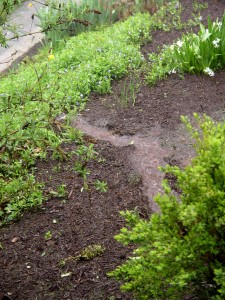Weather Driving You Boggy?
April 19th, 2011
Here’s hoping your garden – and house, for that matter – didn’t float away in Saturday’s deluge.
Outside, the biggest threat was washouts. If you planted something recently in the path that run-off water decided to take, look for your plant in the gutter down the street. You may be able to salvage it by replanting ASAP.
A slightly lesser problem was soil that got washed away from the root zones of plants. If you can rake or add soil back around the roots, the plants should be fine. The longer you let bare roots exposed to the air, the more likely you’ll get dieback. So check around plants and “retrofit” them now.
Soggy soil is a third and more insidious threat. Some plants tolerate “wet feet” pretty well. Others can take a day or two of standing water before trouble starts. Others (mostly Mediterranean plants and those native to dry meadows) start to root-rot if they’re in soggy soil for more than a few hours.
There’s not a whole lot you can do to get rid of standing water once it happens. A better approach is to correct the cause so you don’t run into trouble the next time we get dumped on (and you KNOW there will be a next time).
This storm was actually a good test to get a read on how your property drains. Where did the water run? Did you get washouts? Where did it puddle? How did your spouts and storm-water grading perform?
If you noticed trouble spots, you’ve got two options. One is to address how and where the water reaches the ground. The other is improving the ground’s ability to soak up that water.
Although our house sits up on a ridge, we still got some water in the basement. That happened because the spout was clogged with birch-tree debris, causing 3+ inches of rain to spill out the front of the spouting and into a flower bed along the basement wall.
So Lesson 1 is to keep those spouts clean. Or install one of the various gutter protectors to keep leaves and assorted other debris out of them.
Lesson 2 is to make sure you’ve got extenders at the base of your down-spouts so water is carried away from the house. I see a lot of homes that drop the water right underneath a down-spout. Unless those homes have superb water-proofing, that’s a recipe for water seepage in heavy rain.
Lesson 3 is to break gushers that happen at the end of those extenders. If your spouts are dumping into a mulched bed, heavy storms will blow the mulch out of the way and probably some of the soil underneath.
I head that off by installing circles of mid-sized stones at the end of my spouting. Gushing water hits the stones and slows enough that it then washes more gently out into the lawn. You need big enough stones to withstand that force. River pebbles or gravel won’t cut it.
Lesson 4 is redirecting where the water flows. If water is dumping into a low-lying area, you might want to redirect spouting so it sends water down a different route. (Make sure it’s downhill!)
Some people bury extended drain piping to carry run-off to a more strategic location. That might solve that part of the yard that’s always muddy for days after a storm.
A whole second strategy is “going with the flow.” Instead of the traditional goal of trying to move as much run-off as possible off your property as fast as possible, an increasingly popular option is building “rain gardens” designed to capture rain water.
These gardens are created in slight depressions and improved with generous amounts of sand and compost so water soaks into the ground within two days. The rain garden is then planted with species that tolerate occasional soggy soil (winterberry holly, red osier dogwood, Virginia sweetspire, summersweet, turtlehead, etc.) but that also do fine when the weather is dry.
If you’re interested, here’s a link to a garden column I wrote on building a rain garden:
I’ve also got a new article written on rain gardens scheduled to run in this Thursday’s Patriot-News (and which should end up on the paper’s Pennlive web site .
My wife and I spent the soaking day Saturday leading a garden tour to Winchester, Va. As you might’ve noticed, my weather track record isn’t always very good any time I plan to be in a garden.
Nevertheless, our bus group was filled with gardeners who also are used to getting rained on, and they enjoyed the nice gardens anyway at the Virginia State Arboretum, Historic Long Branch and three of the homes on this year’s Winchester Home and Garden Tour.
Winchester is two hours south of Harrisburg, so their blooms and plant development were at least a week ahead of us.
We’re all running late this year, though, because of the cool and rainy start to the growing season.
We could use a little warmth and sunshine. Otherwise, I’m starting work on an ark.










